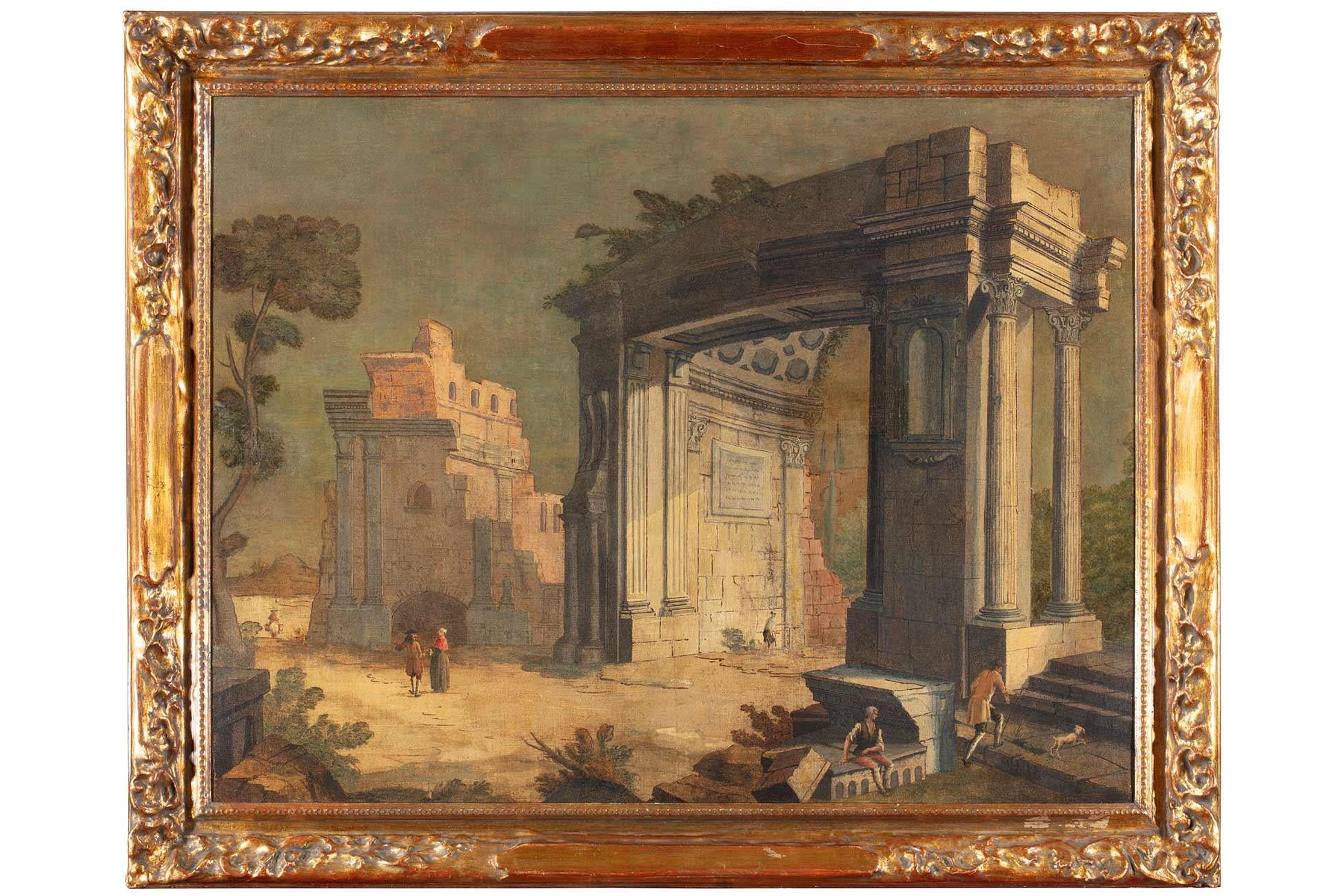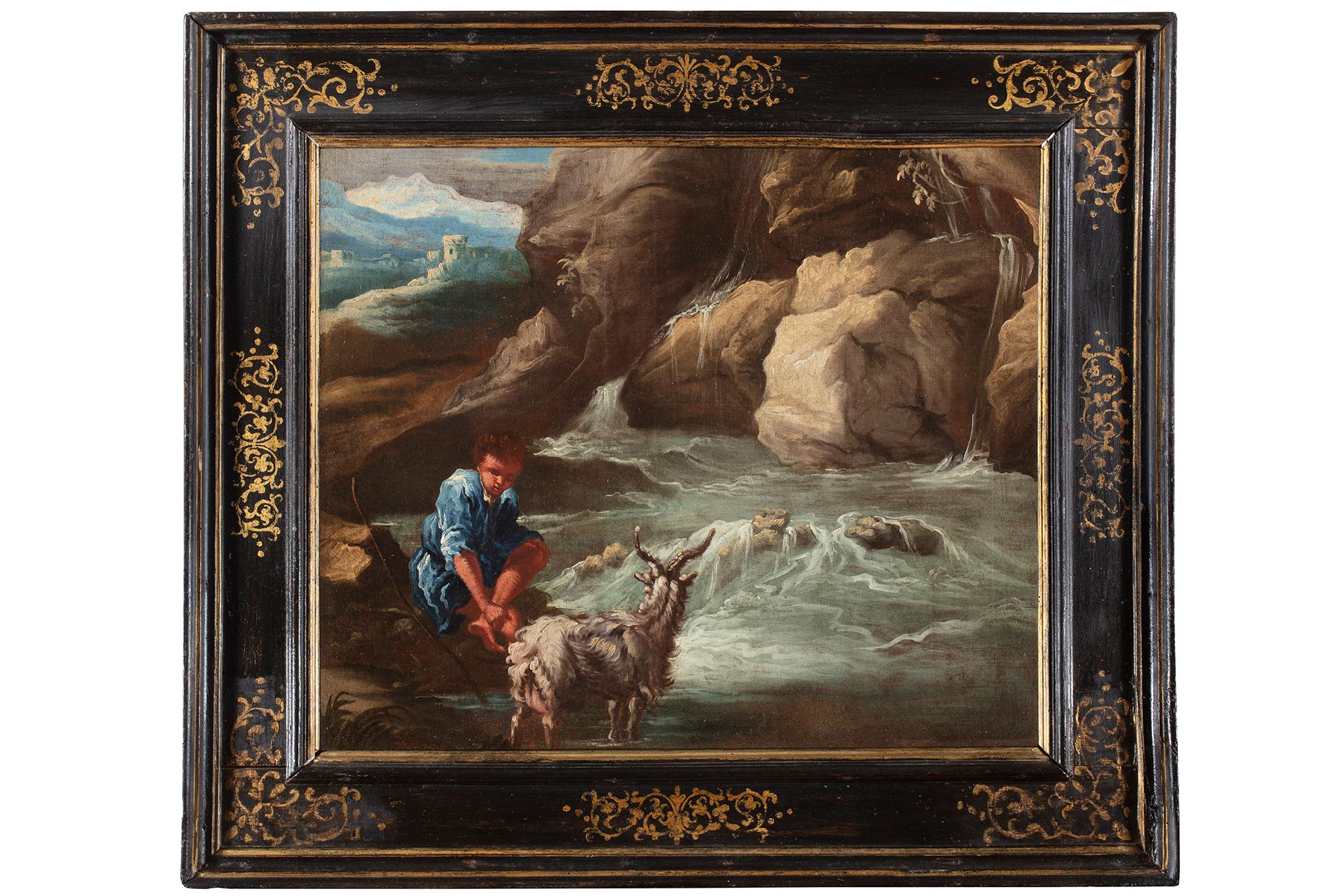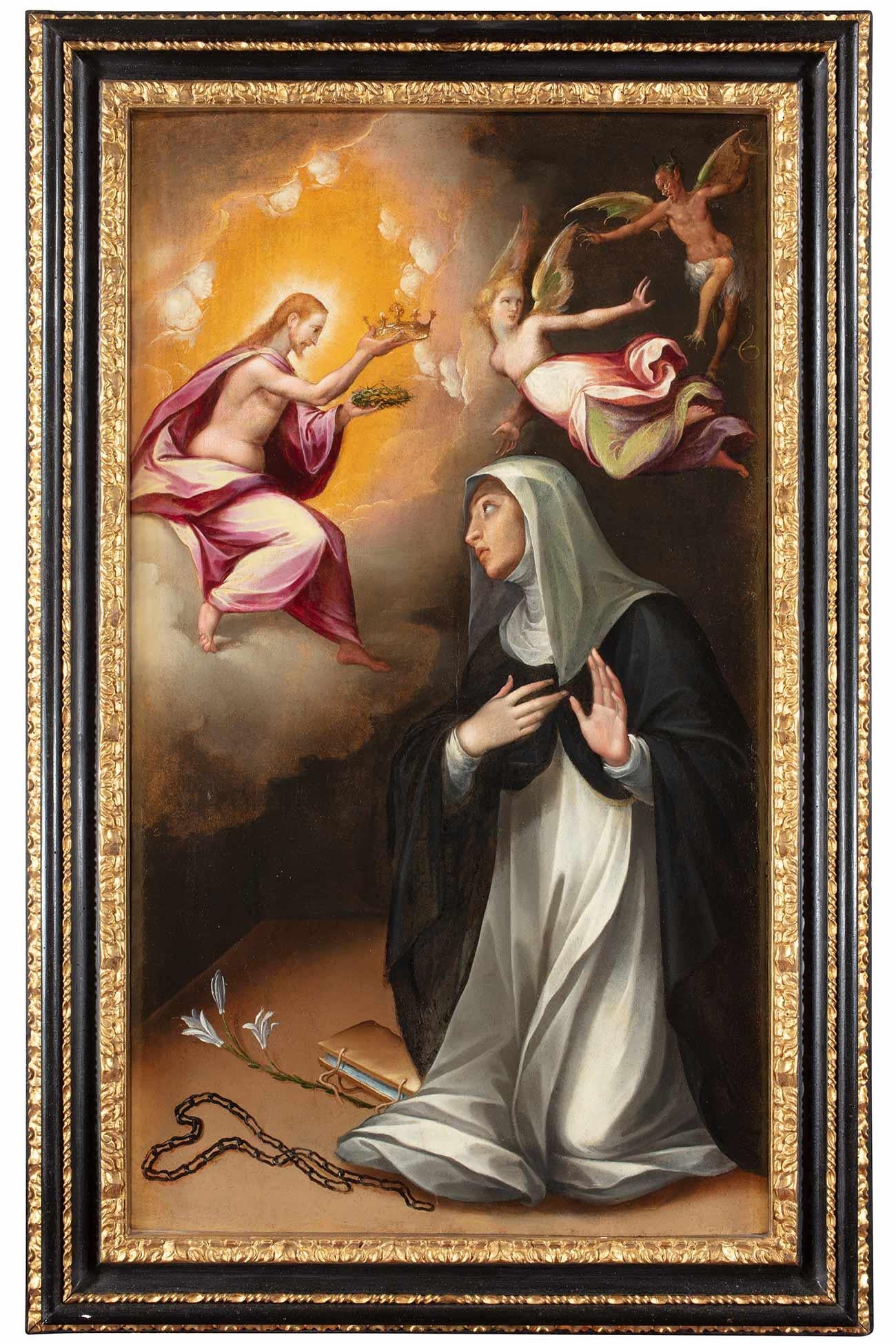Items Similar to Early 19th Century Norwich School oil painting of cottage by a pond
Video Loading
Want more images or videos?
Request additional images or videos from the seller
1 of 21
John Berney CromeEarly 19th Century Norwich School oil painting of cottage by a pond
About the Item
A very atmospheric view of a cottage or outhouse by a pond. The artist has given wonderful texture to the paint to simulate the appearance of the foliage of the trees and vegetation to the foreground of the painting. The scene imbued with a dusky northern light.
John Berney Crome (1794-1842)
Heigham bathing place
Oil on canvas
30 x 25 inches without frame
34 x 29 inches with frame
Catalogue entry from previous sale attached to the reverse.
John Berney Crome was born in Norwich, Norfolk. He was the eldest son (of two) of eight children of John Crome a distinguished landscape artist and founder of the Norwich Society (school) of Artists. John Berney Crome attended Norwich Grammar School until he was 18 years of age, where a friend and fellow pupil was George Vincent (another artist of the Norwich School). As a child, with ambitions of becoming an artist, he accompanied his father on sketching expeditions. By the age of 12 years he was painting in oils and at 16 years was sketching landscapes in water colour. A year later he was selling his paintings. It is said that he inherited the charm of his father. He was an articulate and a good speaker.
Later, Crome assisted his father in teaching, and was appointed landscape painter to the Duke of Sussex. He became a member of the Norwich Society of Artists and exhibited many of his pictures there between 1806 and 1830. He was appointed Vice President of the society in 1818 and subsequently President on several occasions, firstly, in 1819, at the age of 25 years.
On the death of his father in April 1821, Crome continued his father's art teaching practice and occupied the family house in Gildengate Street, Norwich, to which he added a studio. Now, he was probably the leading figure in the Norwich art world. In 1822, the Norwich Mercury, reviewing one of his paintings, felt that he promised to surpass the talents of his father. This promised was never fulfilled. In conjunction with John Sell Cotman (another Norwich School painter who for some time lived at 83, Southtown Road, Great Yarmouth; Plaques in and around Great Yarmouth and Gorleston pp104-5), Crome took a lively interest in the re-opening of the Norwich Society of Artists in 1828, which had closed in 1825 after the demolition of its old premises.
John Berney Crome had many works exhibited at the Royal Academy, the British Institution and the Society of British Artists in London. He made many trips to the continent, drawing and painting in France, Holland, Belgium and Italy. From the mid 1820’s, he painted interminable moonlight scenes. His most famous painting is the Yarmouth Water Frolic, thought to have been started by his father.
Because of his extravagant habits, Crome was made bankrupt in 1831, when the contents of his father's house were sold, and many of his father’s paintings and his own works were disposed of. He moved to Great Yarmouth in 1835, where he continued to teach drawing. He had health problems and, perhaps, a drink problem. He died in September 1842 at his home, 19 King Street, Great Yarmouth. After his death, the Norwich Society of Artists collapsed.
Crome was twice married, leaving a widow, but no children.
John Berney worked in oils, water colours and pencil, painting coastal and rural scenes, both at home and abroad. His work shows the influence of his father, and he painted many moonlight effects. Many of his works can be found at the Castle Museum in Norwich.
The Norwich Society of Artists was started in 1803 by John Berney Crome’s father, John Crome (Old Crome) (1768-1821) and his friend Robert Ladbrooke (1770-1842), as a club where local painters could meet to exchange ideas. Its members included: Henry Bright, Old and Young Crome, Joseph Stannard, James Stark, George Vincent, John Sell Colman, Thomas Lound, etc. The Norwich School's unique achievement was the production of a large body of landscape oils and watercolours, painted largely in the open air by a comparatively small group of self-taught working-class artists.
Source: Hemingway, Andrew, The Norwich School of Painters, Phaidon, Oxford, 1979
- Creator:John Berney Crome (1794 - 1842, English, British)
- Dimensions:Height: 30 in (76.2 cm)Width: 25 in (63.5 cm)Depth: 2 in (5.08 cm)
- Medium:
- Movement & Style:
- Period:
- Condition:
- Gallery Location:Harkstead, GB
- Reference Number:1stDibs: LU1481213286162
About the Seller
5.0
Platinum Seller
These expertly vetted sellers are 1stDibs' most experienced sellers and are rated highest by our customers.
Established in 2002
1stDibs seller since 2021
98 sales on 1stDibs
Typical response time: 1 hour
- ShippingRetrieving quote...Ships From: Harkstead, United Kingdom
- Return PolicyA return for this item may be initiated within 7 days of delivery.
More From This SellerView All
- Old master painting of Cherubs cavorting in a woodland settingBy Jean-Honoré FragonardLocated in Harkstead, GBA charming image of cherubs cavorting with sheaths of wheat in a woodland setting. Follower of Jean-Honoré Fragonard Cherubs cavorting before a tree Oil on panel 10¾ x 14 inches exc...Category
Early 19th Century Old Masters Landscape Paintings
MaterialsOil, Wood Panel
- French Modernist, large Abstract view of an Almond tree with blossom flowersBy Henri-André MartinLocated in Harkstead, GBAn incredibly striking image of an almond tree in flower, the canopy of the tree dominating the whole picture space which gives an abstracted quality to the image, Painted with grea...Category
20th Century Modern Landscape Paintings
MaterialsOil, Canvas
- British impressionist Springtime with blossom in the English countrysideLocated in Harkstead, GBA really appealing view of the English countryside in the springtime with rolling hills, cattle grazing in lush pasture and a windmill off in the distance. George Graham (1881-1949)...Category
Mid-20th Century Impressionist Animal Paintings
MaterialsBoard, Canvas, Oil
- Belgian Impressionist painting of a sunlit villageLocated in Harkstead, GBWonderful Post -Impressionist oil of a sunlit village painted with most attractive brushwork and palette. Henri Vos (1883-1959) A sunlit village Signed Oil on canvas laid down on pa...Category
Early 20th Century Post-Impressionist Landscape Paintings
MaterialsCanvas, Oil, Wood Panel
- French Modernist, large Abstract view of Les Alpilles mountains, ProvenceBy Henri-André MartinLocated in Harkstead, GBA very striking image of an aerial view of Les Alpilles. Les Alpilles are a small mountain range in Provence, South of France. Painted with great energy and with a most appealing tex...Category
20th Century Modern Landscape Paintings
MaterialsOil, Canvas
- Franklin White, British Australian Impressionist scene of a cat in a courtyardBy Franklin WhiteLocated in Harkstead, GBA wonderful image painted in an attractive palette. Franklin White (1892-1975) A cat resting in a sunny courtyard Signed and indistinctly dated (19)41? Oil on canvas laid on board ...Category
Mid-20th Century Impressionist Landscape Paintings
MaterialsBoard, Canvas, Oil
You May Also Like
- Early oil depicting the Great Fire of LondonLocated in London, GBThe Great Fire of London in September 1666 was one of the greatest disasters in the city’s history. The City, with its wooden houses crowded together in narrow streets, was a natural fire risk, and predictions that London would burn down became a shocking reality. The fire began in a bakery in Pudding Lane, an area near the Thames teeming with warehouses and shops full of flammable materials, such as timber, oil, coal, pitch and turpentine. Inevitably the fire spread rapidly from this area into the City. Our painting depicts the impact of the fire on those who were caught in it and creates a very dramatic impression of what the fire was like. Closer inspection reveals a scene of chaos and panic with people running out of the gates. It shows Cripplegate in the north of the City, with St Giles without Cripplegate to its left, in flames (on the site of the present day Barbican). The painting probably represents the fire on the night of Tuesday 4 September, when four-fifths of the City was burning at once, including St Paul's Cathedral. Old St Paul’s can be seen to the right of the canvas, the medieval church with its thick stone walls, was considered a place of safety, but the building was covered in wooden scaffolding as it was in the midst of being restored by the then little known architect, Christopher Wren and caught fire. Our painting seems to depict a specific moment on the Tuesday night when the lead on St Paul’s caught fire and, as the diarist John Evelyn described: ‘the stones of Paul’s flew like grenades, the melting lead running down the streets in a stream and the very pavements glowing with the firey redness, so as no horse, nor man, was able to tread on them.’ Although the loss of life was minimal, some accounts record only sixteen perished, the magnitude of the property loss was shocking – some four hundred and thirty acres, about eighty per cent of the City proper was destroyed, including over thirteen thousand houses, eighty-nine churches, and fifty-two Guild Halls. Thousands were homeless and financially ruined. The Great Fire, and the subsequent fire of 1676, which destroyed over six hundred houses south of the Thames, changed the appearance of London forever. The one constructive outcome of the Great Fire was that the plague, which had devastated the population of London since 1665, diminished greatly, due to the mass death of the plague-carrying rats in the blaze. The fire was widely reported in eyewitness accounts, newspapers, letters and diaries. Samuel Pepys recorded climbing the steeple of Barking Church from which he viewed the destroyed City: ‘the saddest sight of desolation that I ever saw.’ There was an official enquiry into the causes of the fire, petitions to the King and Lord Mayor to rebuild, new legislation and building Acts. Naturally, the fire became a dramatic and extremely popular subject for painters and engravers. A group of works relatively closely related to the present picture have been traditionally ascribed to Jan Griffier...Category
17th Century Old Masters Landscape Paintings
MaterialsOil, Canvas
- 18th Century By Vincenzo Re The Pool of Bethesda Oil on CanvasLocated in Milano, LombardiaExpertise by Prof. Giancarlo Sestieri. Vincenzo Re (Parma, 1695 – Napoli?, 1762) born in Parma, was an Italian scenic designer who during his career worked as initially an assistant...Category
18th Century Old Masters Landscape Paintings
MaterialsCanvas, Oil
- 17th Century by Simone Cantarini Adoration of The Magi Painting Oil on CanvasLocated in Milano, LombardiaSimone Cantarini (Pesaro 1612 - Verona 1648) Adoration of the Magi Oil on paper applied to canvas, cm. 16,5 x 24 – with frame cm. 22 x 29 Antique sh...Category
Early 17th Century Old Masters Figurative Paintings
MaterialsCanvas, Cotton Canvas, Oil
- 18th Century by Antonio Stom Architectural Capriccio Oil on Canvas_By Antonio StomLocated in Milano, LombardiaAntonio Stom (Venice c. 1688 - 1734) Architectural Capriccio oil on canvas, cm. 88 x 113 - with frame cm. 106 x 132 Carved, sculpted and gilded wooden frame Expertise: Giancarlo S...Category
Early 18th Century Old Masters Landscape Paintings
MaterialsCanvas, Cotton Canvas, Oil
- 18th Century by Giuseppe Pianca Shepherd with Goat and River Oil on CanvasLocated in Milano, LombardiaGiuseppe Antonio Pianca (Agnona di Borgosesia/VC, 1703 - after 1757) oil on canvas, cm. 49 x 57 - with frame cm. 67 x 77 Antique shaped wooden cassetta frame, ebony and gold decora...Category
18th Century Old Masters Landscape Paintings
MaterialsCanvas, Cotton Canvas, Oil
- 16th Century by Cristofano Roncalli Saint Catherine of Siena Oil on CanvasLocated in Milano, LombardiaCristofano Roncalli (Pomarance 1552 - Rome 1626) Saint Catherine of Siena chooses the crown of thorns oil on wood, cm. 101,5x59.5 - with frame cm. 120x76 Shaped, carved and sculpted wooden cassetta frame, partly gilded and partly ebonized wood Expertise: Marco Ciampolini The marvellous scene that opens before our eyes is that of Christ's apparition to Saint Catherine of Siena; she must choose between a golden crown, the symbol of earthly royalty, and a crown of thorns, the symbol of virtuous Christian sacrifice. Catherine does not hesitate to choose the crown of thorns, her life in imitation of...Category
16th Century Old Masters Landscape Paintings
MaterialsCanvas, Cotton Canvas, Oil





